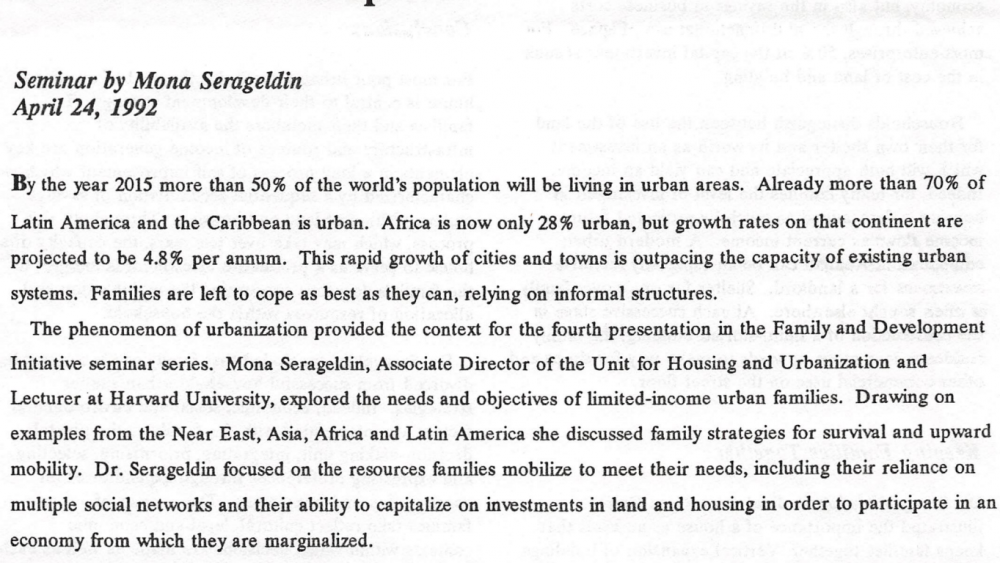Abstract
The Institute for International Urban Development produced a research paper between 2014 to 2016 titled “Inclusive Cities and Access to Land: Housing and Services in Developing Countries.” The World Bank-supported project addressed how global disparities in income, wealth, and opportunity experienced worldwide have contributed to social exclusion and spatial segregation in cities in the Middle East, North Africa, Latin America, Central America and Western Asia.
The Final Report—authored by Dr. Mona Serageldin with I2UD staff, and published in 2016 by the World Bank—documents examples of successful inclusionary policies, programs, and initiatives by public agencies and NGOs with a special focus on cities in Latin America and the Middle East. The reports discussed the difficulty in organizing integrative projects. It underscored the shortcomings arising from acting on one dimension of inclusion—while ignoring others.
Documents include a workshop presentation from January 2014, with a final draft from April 2014. The Final Report from was published by The World Bank as:
Urban Development Series: Knowledge Papers, February 2016, No. 22, Mona Serageldin, Contributors: Sheelah Gobar, Warren Hagist, and Maren Larsen. “Inclusive Cities and Access to Land, Housing, and Services in Developing Countries.” World Bank’s Social, Urban, Rural & Resilience Global Practice, World Bank, 2016.
Excerpt
[Excerpt: Index for the Final Report: “Inclusive Cities and Access to Land, Housing, and Services in Developing Countries.”]
The Growing Importance of Inclusion in Urban Areas
1.1 Defining Inclusion
1.2 Measuring the Dimensions of Exclusion: São Paulo’s Exclusion/Inclusion Indicator Mapping
2. Trends Affecting Social Inclusion in Urban Areas
2.1 Demographics
2.2 Mobility and Migration
3. Infrastructure and Public Services: A Powerful Tool to Promote Social Inclusion
3.1 Rethinking the Approach to Slum Upgrading and Regularization of Informal Settlements
3.2 South Africa’s Municipal Infrastructure Grant Program (MIG)
3.3 Access to Public Services: Social Missions in the the República Bolivariana de Venezuela
4. Restoring the Social Function of Public Space
4.1 Rio de Janeiro’s Favela Bairro Program
5. Access to Land: A Critical Factor at the Core of Inclusion and Exclusion
5.1 Regularizing Tenure in Informal Settlements: Impacts on Social Inclusion
5.2 Impacts of Property Registration on the Inclusion of Informal Settlers
5.3 Integrated Projects to improve the Living Environment: The Role of State Agencies 16
5.4 Egypt’s Informal Settlements Development Facility (ISDF)
6. The Erosion of Inclusive Options for Affordable Housing
6.1 Affordable Housing and Spatial Segregation in Chile
6.2 Looking to Rental Markets as Instruments of Inclusion
7. Generating Revenues to Finance Urban Improvements: Land-Based Financing
7.1 Cuenca’s Improve Your Neighborhood Program
8. The Right to the City
8.1 Implementing the Right to the City in Brazil
8.2 National Legislation and Local Implementation: Colombia’s Policies of Decentralizing the Improvement of Lower Income Settlements
8.3 An Emerging Urban Agenda in the Middle East
8.4 Recife, Brazil (ZEIS)
9. NGOs and CBOs as Strategic Partners in Driving the Implementation of Inclusionary Programs
9.1 Grassroots Initiatives: A Rights-Based Approach
9.2 SEWA
9.3 CODI, Thailand
Concluding Remarks
References
Appendix 1: Indicators of Urban Exclusion and Inclusion in São Paulo, Brazil
Appendix 2: Property Tax and Registration in Middle Eastern Countries
Appendix 3: Statistical Appendix
Appendix 4: Resources
See related I2UD projects below
| Project Year: | 2014-2016 |
| Project Type: | Research Paper |
| Geographic Regions: | Latin America and Middle East / Venezuela / Recife and São Paulo, Brazil / Chile / Colombia / Mexico / Syria / Egypt / Morocco / Tunisia / South Africa / Thailand |
| Reports: | Inclusive Cities: (Final Report, February 2016) — Inclusive Cities: (Workshop Presentation, January 2014) Inclusive Cities: (Final Draft, April 2014) |
| Authors: | Mona Serageldin; Sheelah Gobar; Warren Hagist; Maren Larsen |
| Sponsors: | World Bank |
| Categories: | Informal Settlements and Urban Upgrading |
| ID: | 2014_04_001 |


